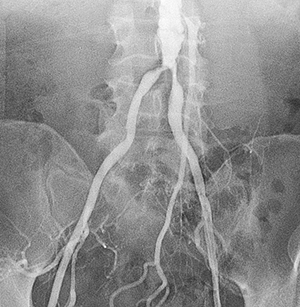Peripheral angiography is a test that uses X-ray and dye (contrast material) to map the blood vessels (arteries) in your lower body, legs, and arms. This map can show where blood flow may be blocked.
Talk with your healthcare provider about the risks and possible complications of angiography.
Before the test
Get ready for the peripheral angiography as follows:
-
Tell your healthcare provider about all medicines you take. This includes prescription and over-the-counter medicines. It also includes vitamins, herbs, and other supplements.
-
Tell your provider about any allergies you may have.
-
Follow any directions you’re given for not eating or drinking before the test. If your provider says to take your normal medicines, swallow them with only small sips of water.
-
Arrange for a family member or friend to drive you home.
During the test
Here is what to expect:
-
You may get medicine through an IV (intravenous) line to relax you. You’re given an injection to numb the insertion site. Then, a tiny skin cut (incision) is made near an artery in your groin.
-
Your healthcare provider inserts a thin tube (catheter) through the incision. They then thread the catheter into an artery while looking at a video screen.
-
Contrast dye is injected into the catheter to confirm position. You may feel warmth or pressure in your legs and back. You lie still as X-rays are taken. The catheter is then taken out.
After the test
You’ll be taken to a recovery area. A healthcare provider will apply pressure to the site for about 10 minutes. You will need to lie flat for several hours. Your healthcare provider will tell you how long to lie down and keep the insertion site still. They will discuss the results with you soon after the test.
Back at home
On the day you get home, don’t drive, exercise, walk, or use stairs. Don't bend or lift anything. Your healthcare provider may give you additional care instructions.
When to call your healthcare provider
Call your healthcare provider right away if:
-
You notice a lump or bleeding at the insertion site, but you can control it with firm pressure
-
You feel pain at the insertion site
-
You don't pee in 8 hours
Call 911
Call 911 right away if you:
-
Notice a lump or bleeding at the insertion site, and you can't control it with firm pressure
-
Become lightheaded or dizzy
-
Have leg pain or numbness, or your leg becomes cold or blue



